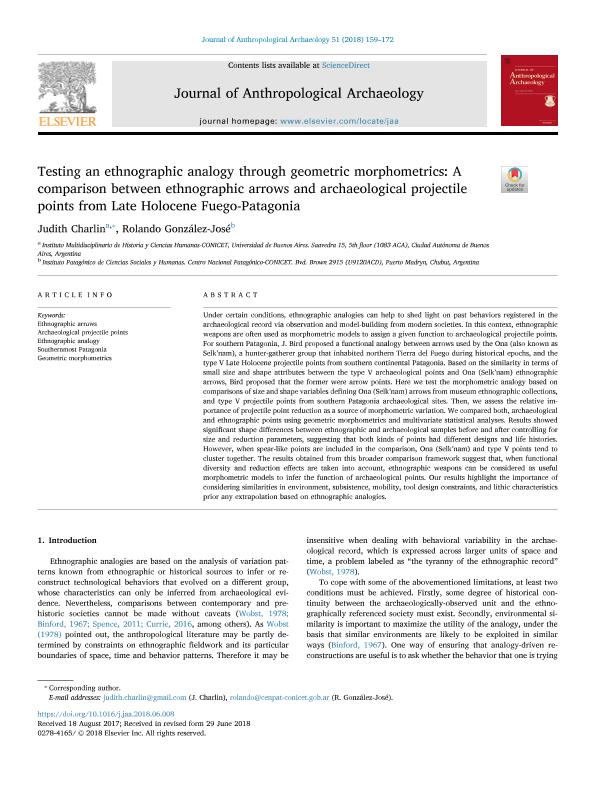Mostrar el registro sencillo del ítem
dc.contributor.author
Charlin, Judith Emilce

dc.contributor.author
González José, Rolando

dc.date.available
2019-10-26T00:01:59Z
dc.date.issued
2018-09
dc.identifier.citation
Charlin, Judith Emilce; González José, Rolando; Testing an ethnographic analogy through geometric morphometrics: A comparison between ethnographic arrows and archaeological projectile points from Late Holocene Fuego-Patagonia; Academic Press Inc Elsevier Science; Journal of Anthropological Archaeology; 51; 9-2018; 159-172
dc.identifier.issn
0278-4165
dc.identifier.uri
http://hdl.handle.net/11336/87365
dc.description.abstract
Under certain conditions, ethnographic analogies can help to shed light on past behaviors registered in the archaeological record via observation and model-building from modern societies. In this context, ethnographic weapons are often used as morphometric models to assign a given function to archaeological projectile points. For southern Patagonia, J. Bird proposed a functional analogy between arrows used by the Ona (also known as Selk'nam), a hunter-gatherer group that inhabited northern Tierra del Fuego during historical epochs, and the type V Late Holocene projectile points from southern continental Patagonia. Based on the similarity in terms of small size and shape attributes between the type V archaeological points and Ona (Selk'nam) ethnographic arrows, Bird proposed that the former were arrow points. Here we test the morphometric analogy based on comparisons of size and shape variables defining Ona (Selk'nam) arrows from museum ethnographic collections, and type V projectile points from southern Patagonia archaeological sites. Then, we assess the relative importance of projectile point reduction as a source of morphometric variation. We compared both, archaeological and ethnographic points using geometric morphometrics and multivariate statistical analyses. Results showed significant shape differences between ethnographic and archaeological samples before and after controlling for size and reduction parameters, suggesting that both kinds of points had different designs and life histories. However, when spear-like points are included in the comparison, Ona (Selk'nam) and type V points tend to cluster together. The results obtained from this broader comparison framework suggest that, when functional diversity and reduction effects are taken into account, ethnographic weapons can be considered as useful morphometric models to infer the function of archaeological points. Our results highlight the importance of considering similarities in environment, subsistence, mobility, tool design constraints, and lithic characteristics prior any extrapolation based on ethnographic analogies.
dc.format
application/pdf
dc.language.iso
eng
dc.publisher
Academic Press Inc Elsevier Science

dc.rights
info:eu-repo/semantics/openAccess
dc.rights.uri
https://creativecommons.org/licenses/by-nc-sa/2.5/ar/
dc.subject
ARCHAEOLOGICAL PROJECTILE POINTS
dc.subject
ETHNOGRAPHIC ANALOGY
dc.subject
ETHNOGRAPHIC ARROWS
dc.subject
GEOMETRIC MORPHOMETRICS
dc.subject
SOUTHERNMOST PATAGONIA
dc.subject.classification
Arqueología

dc.subject.classification
Historia y Arqueología

dc.subject.classification
HUMANIDADES

dc.title
Testing an ethnographic analogy through geometric morphometrics: A comparison between ethnographic arrows and archaeological projectile points from Late Holocene Fuego-Patagonia
dc.type
info:eu-repo/semantics/article
dc.type
info:ar-repo/semantics/artículo
dc.type
info:eu-repo/semantics/publishedVersion
dc.date.updated
2019-10-08T12:51:14Z
dc.identifier.eissn
1090-2686
dc.journal.volume
51
dc.journal.pagination
159-172
dc.journal.pais
Estados Unidos

dc.description.fil
Fil: Charlin, Judith Emilce. Consejo Nacional de Investigaciones Científicas y Técnicas. Oficina de Coordinación Administrativa Saavedra 15. Instituto Multidisciplinario de Historia y Ciencias Humanas; Argentina
dc.description.fil
Fil: González José, Rolando. Consejo Nacional de Investigaciones Científicas y Técnicas. Centro Científico Tecnológico Conicet - Centro Nacional Patagónico. Instituto Patagónico de Ciencias Sociales y Humanas; Argentina
dc.journal.title
Journal of Anthropological Archaeology
dc.relation.alternativeid
info:eu-repo/semantics/altIdentifier/url/https://www.sciencedirect.com/science/article/pii/S0278416517301393
dc.relation.alternativeid
info:eu-repo/semantics/altIdentifier/doi/http://dx.doi.org/10.1016/j.jaa.2018.06.008
Archivos asociados
